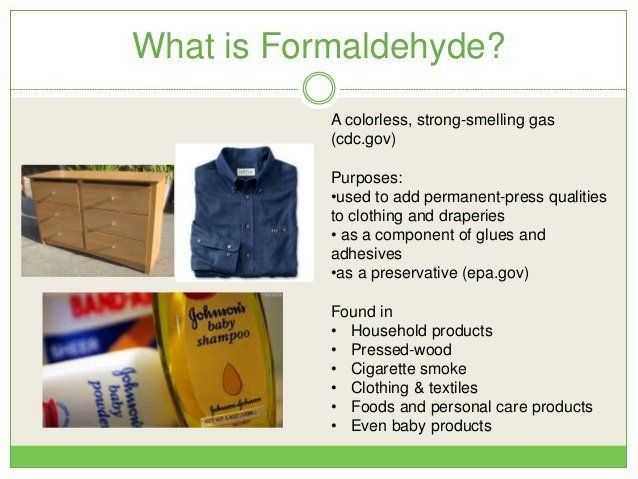Formaldehyde (FA) is a gas at room temperature. It is a single carbon aldehyde that plays a key role in single carbon metabolism. Recently, it has been recognized that FA is important in the methylglyoxal cycle, which is formed from glyceraldehydes-3-phosphate. FA is highly reactive. It chemically reacts with biological molecules, amino acids, nucleosides, nucleotides, DNA and proteins and forms DNA-protein crosslinks. Thus, it is recognized as a mutagen and a probable human carcinogen.
The following occupational exposure levels have been set:
OSHA TWA = 0,75 ppm (action level of 0.5 ppm and a TEL of 2 ppm); ACGII-ITLV = 0.3 ppm; NIOSH REL = 0.016 ppm (0.1 ppm ceiling).
OSHA and ACGIH standards apply to the work place, adult male.
These standards do not apply to the home environment.
Neither are they applicable to the elderly, the young and those with pre-existing health problems.
ATSDR has recommended Minimal Risk Levels (MIL) as follows:
Acute WEL = 0,04 ppm for 1 to 14 clays, Intermediate = 0,03 pprn for 15 to 364 days Long Term ILL = 0,008 ppm for 365 days and greater.
FA is toxic to humans and animals. It is irritating to the eyes, nose and upper respiratory tract. It has been shown to cause both irritation and allergic contact dermatitis. It can aggravate existing lung disease (asthma, emphysema, etc.). Asthma caused by FA is rare, but does occur.
Antibodies to FA have been demonstrated in the blood of individuals exposed through inhalation and FA-treated kidney dialysis membranes.
Other toxic effects of FA in humans are:
Immune System
Individuals exposed to FA in mobile homes have been shown to have alterations in their lymphocyte subsets and an increase in multiple-organ autoantibodies (lupus-like condition). Medical students in anatomy class have altered peripheral lymphocyte subsets and an increase in chromosome aberrations of peripheral lymphocytes
Nervous System
FA causes headaches. Measurable decrements in CNS functions in histology technicians occur as follows: memory and concentration, disturbed sleep, impaired balance, variations in mood and irritability. Individuals living in mobile homes complain of similar symptoms plus chronic fatigue.
Reproductive
Occupational exposure to FA is associated with reproductive problems in women. These are a decrease in fecundity and spontaneous abortions.
Embryo Toxicity
Studies published in English have shown no embryo toxic effects of FA in research animals (rats, guinea pigs). In contrast, foreign research has shown that FA crosses the placenta, enters the fetus and remains in fetal tissues longer than maternal tissues in mice. Studies on rats have shown an increased rate of embryonic death, birth defects and abnormalities in fetal mitochondria. Young pups do not mature as rapidly as normal control animals.
The difference between the foreign and English studies is the method of exposure. English studies have exposed pregnant rodents to FA beginning approximately on the 6th day of gestation. The foreign investigations were done with two exposure scenarios. In one, females were exposed prior to mating, mated, and then exposed throughout gestation. In the other, pregnant females were exposed from the 1st to 20 to 21 days of pregnancy.
Both of these types of investigations showed effects on embryonic development and fetal organs (liver, lungs kidneys). The mitochondrial damage was demonstrated in fetal tissues.
Carcinogen
Formaldehyde is now accepted as a carcinogen. Workers exposed to the chemical develop nasopharyngeal cancer.
A recent NIOSH review of exposed workers strongly suggests a link with various blood cancers.
Summary
You can be exposed to FA in your home or workplace. The sources of FA in the home are new construction materials (particle board, medium density fiber board, plywood), surface finishes, and a wide variety of consumer products.
The bottom line is: If you live in a newly constructed home (framed, modular, mobile home) and are experiencing symptoms that include eye irritation, chronic upper respiratory infections, headaches, flu-like illness, fatigue, etc., check your home for FA emitters such as particle board.
FA may cause menstrual irregularities, miscarriages and possible birth defects.
The recent controversy regarding FEMA trailers and formaldehyde is still unfolding. It seems the Federal Government does not recognize the published medical and scientific literature nor their own publications on the adverse health effects of exposure to formaldehyde.
References
Al–Saraj AA (2009) Teratogenic effects of formaldehyde in rabbits. Iraqi J Vet Sci 23:1-4.
Freeman LE, Blair A, et al (2009) Mortality from lymphohematopoietic malignancies among workers in formaldehyde industries: The National Cancer Institute cohort. J Natl Cancer Inst 101:751-61.
Kilburn KH, et al (1985) Neurobehavioral and respiratory symptoms of formaldehyde and xylene exposure in histology technicians. Arch Environ Health 40:229.
Kilburn KH, et al (1987) Formaldehyde impairs memory, equilibrium and dexterity in histology technicians: effects which persist for days after exposure. Arch Environ Health 42:117.
Kilburn KH, et al (1989) Pulmonary function in histology technicians compared with women from Michigan: effects of chronic low dose of formaldehyde on a national sample of women. Br J Ind Med 46:468.
Madison R, Broughton A, Thrasher JD (1991) Immunologic biomarkers associated with an acute exposure to exothermic by products of an ureaformaldehyde spill. Environ Health Perspect 94:219.
Thrasher JD, Broughton A, Madison R (1990) Immune activation and autoantibodies in humans with long term inhalation exposure to formaldehyde. Arch Environ Health 45:217.
Thrasher JD, Kilburn KH (2001) Embryo Toxicity and Teratogenecity of Formaldehyde. Arch Environ Health. 56:300.
Thrasher JD, Vojdani A, Heuser G, Cheung GP (1987) Evidence for formaldehyde antibodies and altered immunity in subjects exposed to formaldehyde in mobile homes. A brief communication. Arch Environ Health 42:347.
Formaldehyde has been linked to cancer of the blood and lymphatic system by the National Cancer Institute. In 2011, formaldehyde was added to the list of human carcinogens. Read the press release. 
